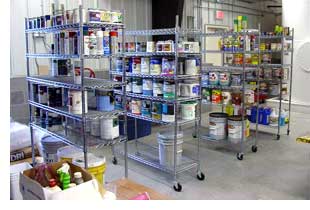Household Hazardous Waste:
 Household
hazardous wastes (HHW) are common household items that contain corrosive, toxic, ignitable, or reactive ingredients and should be
handled, stored, and disposed of properly.
Household
hazardous wastes (HHW) are common household items that contain corrosive, toxic, ignitable, or reactive ingredients and should be
handled, stored, and disposed of properly.- Corrosive - Eats away substances - cloth, metals and skin.
Acids and caustics - Battery acid, Pool chemicals, Toilet/drain cleaners - Flammable - Ignites easily.
Gasoline - Lighter fluids - Motor oil, Paint thinner, Propane cylinders - Reactive - Creates explosion or deadly fumes.
Ammonia and Bleach mix, Chlorine - Fertilizers, Cyanides - Toxic - Poisonous or lethal when swallowed, touched or inhaled.
Antifreeze - Pesticides, Rat poison - Weed killers
Cleaners, batteries, paint, oils, electronics, and fluorescent lights are examples of HHW. When used or disposed of improperly these products are a source of potential harm to our bodies and/or the environment. Contaminants from HHW can include cadmium, mercury, lead, benzene, ethylene glycol, and polychlorinated biphenyls (PCBs).
Warning labels, such as poison, danger, and caution, identify products that are hazardous when used improperly. However, there are many products in our homes that do not have warning labels that may contain hazardous materials when broken or disposed of improperly. For example, fluorescent lights, thermostat and appliance switches, batteries, children’s shoes that light up, and thermometers all contain mercury. Electronics contain many heavy metals that can contaminate the groundwater or air if illegally dumped or burned.
The local hazardous waste management program in King County, Washington has developed an extensive list of household hazardous products available at their website. The rollover information describes how to dispose of these items in their community and the link on each product provides information on potential hazards and safer alternatives.
Contaminants of Concern:
Contaminants of concern will be specific to the household hazardous waste product. Batteries are a particularly significant source of metal contamination. Even after 80% of lead-acid automotive batteries are recovered for recycling, the remaining 20% are estimated to contribute 66% of the lead in municipal solid waste nationally. Household batteries account for approximately 90% of the mercury, though that level has been declining greatly as manufacturers remove mercury from alkaline batteries. Nickel-cadmium batteries may be responsible for up to 52% of the cadmium. Another study has estimated that 27% of the lead and 9% of the cadmium are contributed by consumer electronic goods.Implementing Solutions:
Inform your community about the dangers associated with HHW with the intention to reduce, recycle, and dispose of HHW properly.Use safer alternatives to hazardous household cleaning products. Many resources such as Alaska Community Action on Toxics' Green Cleaning Guide and Recipe Book are available online.
Set up a Reuse/Exchange Center for Household Hazardous Waste to ensure products are used up instead of being disposed of.
Please submit your experiences (successes/challenges) and tribal-specific documents to share on our website using the attached form.
Download Form
Resources:
EPA Household Hazardous Waste Collection: A Program Guide for Tribal Governments [pdf]Household and Commercial Cleaning Products:
EPA Registered Hard Surface Disinfectants Comparison Chart [pdf]Cleaning Chemical Injuries Fact Sheet for Professional Janitors [pdf]
Cleaning for Health: Products and Practices for a Safer Indoor Environment Guidebook [pdf]
Cleaning for Healthy Schools – Infection Control Handbook [pdf]
What's That Smell? A look at common chemicals in fragrance in cleaning products and their associated health impacts. [pdf]
The Hidden Life of What’s Under Your Sink [pdf]
Mercury:
Mercury: In Your Community and the Environment [pdf]EPA Compact Fluorescent Light Bulb Brochure with Cleanup Procedures 2011 [pdf]
EPA Compact Fluorescent Light Bulb Detailed Cleanup Procedures 2010 [pdf]
Websites:
Saint Regis Mohawk Tribe's Tribal Guide for Managing Household Hazardous Waste:www.srmt-nsn.gov/_uploads/site_files/SRMT_HHW_Manual.pdf
EPA Household Hazardous Waste Website:
www.epa.gov/hw/household-hazardous-waste-hhw
Zender Environmental Health and Research Group Fact Sheets and Guidance Documents:
www.zendergroup.org/viewdocs.htm
Related Pages:
BurningRCRA
Research Individual Chemicals
For more information, please contact:
Jennifer Williams, Alaska Program Coordinator, Sr.
Tel: 928/523-0673
Email: Jennifer.Williams@nau.edu
Tel: 928/523-0673
Email: Jennifer.Williams@nau.edu
Last updated: July 10, 2015
